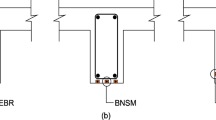Abstract
The use of high-strength and highly flexible wire ropes as internal shear reinforcement may be a solution to reduce the congestion of steel reinforcements and facilitate their installation in reinforced concrete (RC) elements. This paper aims to study the effectiveness of continuous wire ropes in substituting traditional shear reinforcement and its effect on the RC beam’s shear behavior. Four-point bending tests were performed on 32 beam specimens. Fourteen different configurations of shear reinforcement were tested, of which four were reinforced in a conventional manner and ten with wire ropes. Deflection and crack opening were measured using Digital Image Correlation (DIC) technique. Test results show that the experimental shear capacities of beams with wire ropes are in good agreement with the estimated theoretical values. The difference in behavior of the two types of beams—transversely reinforced with wire ropes or traditional steel rebars—occurs at the appearance of the first diagonal crack. A progressive evolution of the crack opening occurs when using traditional rebars, while a sudden crack opening accompanied by loss of shear strength occurs in beams reinforced with wire ropes. This sudden loss is repeated several times during the test before reaching the final failure drop. The conjunction of two phenomena may be at the origin of this difference in the beam behavior: the smooth stiffness of the wire rope under tensile stresses associated with a weak wire rope-concrete bond.











Similar content being viewed by others
References
Cladera A, Marí AR (2007) Shear strength in the new eurocode 2. a step forward? Struct Concr 8(2):57–66
Colyvas GM, Malecot Y, Sieffert Y, Aboudha S, Kanali C (2020) Behavior of reinforced concrete beams using wire rope as internal shear reinforcement. Eng Technol Appl Sci Res 10(4):5940–5946
Demir A, Caglar N, Ozturk H, Sumer Y (2016) Nonlinear finite element study on the improvement of shear capacity in reinforced concrete t-section beams by an alternative diagonal shear reinforcement. Eng Struct 120:158–165
Dhakal RP, Su J (2018) Design of transverse reinforcement to avoid premature buckling of main bars. Earthq Eng Struct Dyn 47(1):147–168
Eurocode 2 (2005) Eurocode 2, - EN 1992-1-1, Design of Concrete Structures, General Rules and Rules for Buildings, Comité Européen de Normalisation Eurocode2 - EN 1992-1-1
Fiset M, Bastien J, Mitchell D (2019) Shear strengthening of concrete members with unbonded transverse reinforcement. Eng Struct 180:40–49
Ju M, Park Y, Park C (2017) Cracking control comparison in the specifications of serviceability in cracking for FRP reinforced concrete beams. Compos Struct 182:674–684
Karayannis C, Chalioris C (2013) Shear tests of reinforced concrete beams with continuous rectangular spiral reinforcement. Constr Build Mater 46:86–97
Karim H, Sheikh MN, Hadi MN (2014) Confinement of circular concrete columns: a review. In: Proceeding of The 1st international engineering conference on developments in civil & computer engineering applications (IEC2014). pp 28–36
Lee J-Y, Choi I-J, Kim S-W (2011) Shear behavior of reinforced concrete beams with high-strength stirrups. ACI Struct J 108(5):620–629
Michaud É (2014) Résistance en cisaillement des poutres en béton armé renforcé de fibres d’acier et synthétiques avec analyse de l’effet d’échelle. Ph.D. thesis, Université de Sherbrooke
Olalusi OB (2019) Present state of eurocode 2 variable strut inclination method for shear design and possible improvement. In: Structures. vol 19. Elsevier pp 48–57
Paillé J-M (2009) Calcul des structures en béton. Editions Eyrolles
Paultre P (2011) Structures en béton armé: analyse et dimensionnement. Presses inter Polytechnique
Pereiro-Barceló J, Senach JLB, Albiol-Ibáñez JR (2018) Required tie spacing to prevent inelastic local buckling of longitudinal reinforcements in RC and FRC elements. Eng Struct 160:328–341
Ricotier D (2012) Dimensionnement des structures en béton selon l’Eurocode 2: de la descente de charges aux plans de ferraillage. Le Moniteur Edition
Robinson J (2019) Premiers essais sur les aciers de couture
Shatarat N, Katkhuda H, Alqam M et al (2016) Experimental investigation of reinforced concrete beams with spiral reinforcement in shear. Constr Build Mater 125:585–594
Shatarat N, Mahmoud HM, Katkhuda H (2018) Shear capacity investigation of self compacting concrete beams with rectangular spiral reinforcement. Constr Build Mater 189:640–648
Sumpter MS, Rizkalla SH, Zia P (2010) Behavior of high-performance steel as shear reinforcement for concrete beams. ACI Struct J 107(1):122–124
Trad A (2011) Analyse du comportement et modélisation de structures souples de protection: le cas des écrans de filets pare-pierres sous sollicitations statique et dynamique. Ph.D. thesis, INSA de Lyon
Wang W, Zhang M, Tang Y, Zhang X, Ding X (2017) Behaviour of high-strength concrete columns confined by spiral reinforcement under uniaxial compression. Constr Build Mater 154:496–503
Wang Z, Feng P, Zhao Y, Yu T (2019) FRP-confined concrete core-encased rebar for RC columns: concept and axial compressive behavior. Compos Struct 222:110915
Yang K-H, Kim G-H, Yang H-S (2011) Shear behavior of continuous reinforced concrete t-beams using wire rope as internal shear reinforcement. Constr Build Mater 25(2):911–918
Author information
Authors and Affiliations
Corresponding author
Additional information
Publisher's Note
Springer Nature remains neutral with regard to jurisdictional claims in published maps and institutional affiliations.
Rights and permissions
Springer Nature or its licensor (e.g. a society or other partner) holds exclusive rights to this article under a publishing agreement with the author(s) or other rightsholder(s); author self-archiving of the accepted manuscript version of this article is solely governed by the terms of such publishing agreement and applicable law.
About this article
Cite this article
Rouphael, D., Vieux-Champagne, F., Sieffert, Y. et al. Shear behavior of reinforced concrete beams with wire rope shear reinforcement. Mater Struct 56, 114 (2023). https://doi.org/10.1617/s11527-023-02199-5
Received:
Accepted:
Published:
DOI: https://doi.org/10.1617/s11527-023-02199-5




